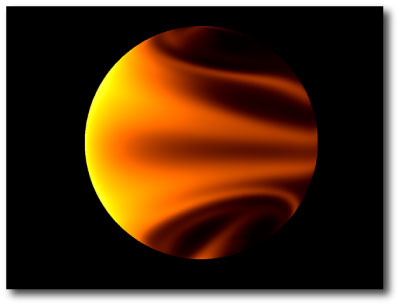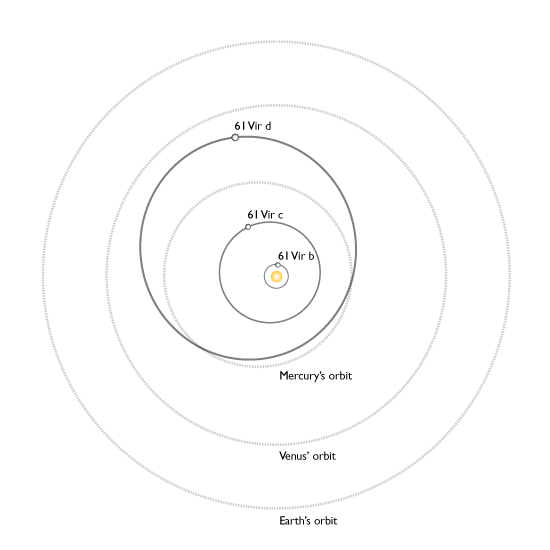The ranks of the super Earths and the sub Neptunes continue to grow! In two papers that have been accepted by the Astrophysical Journal, and which will be coming out in tomorrow’s astro-ph mailing, the Earthbound Planet Search team is announcing the detection of very low mass planets orbiting the nearby solar twins 61 Vir and HD 1461. (Link to paper #1, link to paper #2).
The 61 Vir system is particularly compelling. The radial velocity data for this star indicate that at least three planets are present, with an architecture that’s quite a bit more crowded than the Sun’s terrestrial planet zone:
The innermost planet, 61 Vir b, with Msin(i)~5.5 Earth masses, has a radial velocity half-amplitude K=2.15 m/s, which puts it in league with Gl581e (with K=1.9 m/s) and HD40307b (with K=2.0 m.s) as the lowest-amplitude Doppler detections to date.
We’ve adopted the Systemic Console software to analyze the Doppler velocities that are produced by the Earthbound Planet Search. I’ve written a tutorial (link here) that explores the 61 Vir dataset in detail, and shows how the planets are extracted.



So do we call these super-Earths or mini-Neptunes? There are certainly some interesting rumours going around these days…
Pingback: Tweets that mention systemic » Earthbound Planet Search -- Topsy.com
Jury is still out, but they’ve sent a note to the judge that an announcement is imminent…
If CoRoT-7b is in any way typical (which seems highly doubtful, given its extreme orbit) then they’re “super Earths”. More likely, though, they’re more like Uranus and Neptune. As members of this class of planets are found in transit, the story will become clear. There’s a big radius difference between an object made of rock and iron and one made primarily of water.
Not an expert but a curious observer. I wonder why the planet hunting is such a difficult task. Were there two hubble like satellites orbitting at Jupiter distances to the sun at 180 rotation in orbit to each other, surely all spots of light around all stars within a large radius of us would then be visible by cancelling out the star light from each picture. What remains will be two impression of those reflected bodies around the star.
As I say I am no expert, but I wonder why this has not occurred to anyone or has been proposed. Perhaps, in my ignorance, I fail to understand this is unachievable.
I would certainly appreciate being corrected if misguided.
The data looks very noisy to me. The amplitude of scatter in residuals is similar to that of the claimed planets. How does one know for sure these are due to planets?
Presumably the bootstrap mentioned in Tutorial 4 is for the keplerian option? (Unless I’ve missed something). I’ve just uploaded the new console and have noticed that it has the facility to deal with non-coplanar systems (amongst the other additions) – pretty cool!
Try the new Console on GJ876 – with the option to fit inclined systems, it should be possible to get the fits from Rivera et al 2005 (ApJ 634, 625) and from Bean & Seifahrt 2009 (A&A 496, 249).
Joe, it sounds like you are proposing some variation of either a space-based interferometric or coronographic detection scheme. A good deal of work has been done on this topic, and while detection and characterization of low-mass planets can indeed be done in this fashion (see, e.g. the NASA TPF mission) it’s neither easy nor cheap. Ultimately, though, if we’re going to get good characterizations of nearby extrasolar terrestrial planets, it’ll have to be done from space.
bbtomalex, It’s true that the amplitude of the signal is similar to the per-point velocity scatter, but there are a large number of observations, and the periodic signals are present in the data to very high confidence. In the papers, we discuss the statistical arguments in detail.
The only way that one can _truly_ be sure that a given periodic radial velocity signal is due to a planet is if the planet is found to transit, or is confirmed by some other means such as astrometry or direct observation via reflected starlight. Prior to the discovery of the HD 209458b transits in 1999, there was a vocal minority of scientists who believed that the observed radial velocity variations from stars like 51 Peg were due not to planets, but to stellar oscillations.
Pete j, glad you like the new console. Stefano burned the midnight oil to get this latest Dist out the door. The bootstrap is indeed for the Keplerian option.
@greg
Is there any reason not to expect a continuous mix between rocky and icy planets? e.g. wetter Europas, or rockier Ganymedes?
Pingback: New ’super-Earths’ discovered « Exploration and Life
cwmagee, I’m quite sure that’ll end up being the case. It’ll be interesting to see what the density distribution looks like.
Greg, Stefano, I like the new console, but still missing the backend (nowhere to post comments such as below). Any news on this? I have had a quick look at the console and seem to have found a bug: after running a fit and switching to a new star system without closing the console, the display of the RV data for the new system momentarily displays as expected and then collapses to a narrow column at the Left hand margin – something wrong with the scaling of dates? – and the console locks up. This happened when I used 55Cancri 4datasets, my default for testing the console.
Hi Mike,
Thanks for the bug report, we’ll get on that. The backend is still being reworked — we’ve been working with two talented undergrad programmers to give it an overhaul — they’ve been slowed down by their final exams and class coding projects, but it really should be up soon. At the moment, I’ve been working to make sure that Transitsearch.org is fully operational, as there are several external articles about it currently in circulation.
Eugenio – thanks for that, I’ll investigate GJ876 – with the option to fit inclined systems.
As Mike, I’m eager for the backend to be up and running as well. I’ve had an e-mail recently about when the backend would be ready.
Pingback: Chronik des Universums: erste Dezember-Hälfte 2009 « Skyweek Zwei Punkt Null
Hi Mike,
Updated console is on line now.